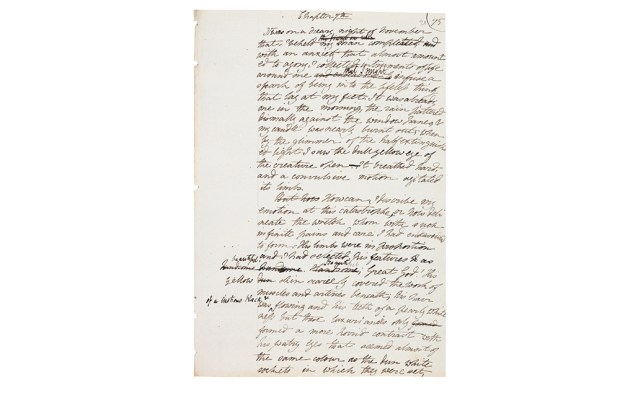Do movie musicals matter? Most readers, even those who love them, will embark on Richard Barrios’s short history of the genre with the thought: not much. They’ll very likely, I’m afraid, finish it holding much the same opinion. But not mattering much doesn’t prevent the best film musicals from being captivating. This is a book by someone who is indeed captivated: a love letter for the best of musical cinema and a blown raspberry for the worst.
Barrios is sensitive and scholarly about the ebb and flow of the popularity of musical film over the years — the dunts administered to it by 1934’s killjoy Production Code, by changes in cinema distribution models, by the rise of pop music and television, and above all by the boom-and-bust effect of a big hit appearing to presage the return of the musical (even though Cabaret and Les Misérables, in different generations, proved dead ends).
He makes the obvious but important point early on that ‘musical film and musical theater are cousins, not siblings’. Or, as he rather pleasingly puts it later, in the context of transferring films to stage and vice versa: ‘while it’s OK for the lion to dance with the lamb, the choreographer in charge needs skill and sense’. Most of all, he argues, no musical can work if it does not connect with a) its audience, and b) the history of its genre. He outlines the ways in which film musicals found their own vocabulary of gestures and techniques — including ways to naturalise the awkward ‘bump’ moment at which a character might burst into song.
Barrios is keen to scotch the idea that The Jazz Singer was the fons et origo of musical cinema. For him, the more important trail-blazers are now forgotten: The Desert Song (1929), described by one latter-day viewer as ‘the oldest movie ever made’; and The Broadway Melody (1929), which ‘by laying out everything that would be expanded and refined later […] made itself obsolete’.
It’s striking how — for something we think of as dated — musicals have always been postmodern: drawing attention to their artificiality, referencing their predecessors, tearing down the fourth wall. Many of the greatest — such as Singin’ in the Rain — have been ‘backstagers’: musical films about people making musical films. That, among other things, is a classic technique for getting over the ‘bump’.
Chapters on the money and on the stars have very sensible and perceptive things to say. Barrios notes the fantastic professionalism of Fred Astaire, who made himself dance slightly badly so as to make clumping Joan Crawford look better. And he judges that in a leading lady ‘glamour seemed to matter less than spunk’. It’s amazing to learn, incidentally, that the worldwide gross of Big Boy was not enough to cover Al Jolson’s salary.
Smitten with the musicals of the past, Barrios is nevertheless unstuffy about those of the present. The late 1980s rapper Vanilla Ice even merits two mentions in the Index (under V). Barrios administers a stern ticking off to the modern TV campfest Glee for an ‘abrogation of responsibility’: it devoted too much time to ‘the trifling oeuvre of Britney Spears’ and missed a golden opportunity to educate its audience in the great tradition of musical cinema. But he delights in High School Musical and thinks, rightly, that South Park: Bigger, Longer and Uncut is completely magnificent.
Along the way, he mentions some lost or underappreciated gems that make you immediately want to seek them out. Did you know that there was a Dr Seuss musical with the unimprovably enticing name The 5,000 Fingers of Dr. T? Or, Cecil B. DeMille’s 1930 musical Madam Satan, a love-triangle story featuring a masquerade party set aboard a zeppelin, where chorines dressed as clocks sound the hour by striking themselves on the head, before lightning strikes and the heroine parachutes from the burning zeppelin and lands in a Turkish bath? That sounds well worth checking out. Not to mention the Spielberg movie featuring ‘Jewish immigrant mice’, and the old flick where a dog barks the chorus to one of the songs.
So there are good things in here. But they do take some truffling out. Barrios’s style — infected slightly by Walter Winchell, I fancy — has a wearyingly cockeyed flamboyance: staccato here, over-tricksy there. One minute it gushes: ‘most seminal cultural influence… everlasting wonder… sheer brash timelessness… triumph… glories… brilliance’ appear in a single paragraph; and the next it romps off into some insane pudding simile: ‘With its mad Technicolor outbursts and rococo surfaces, Yolanda is as a magnificent pastry, with meringue and sprinkles and icing piled on beguilingly without cease, while the substance beneath it all is a cracked sliver of melba toast.’
An additional bar to entry is that Barrios is a) a bit disorganised, and b) tends to take his audience’s familiarity with many of these long-forgotten musicals a bit for granted. The first couple of chapters are the hardest going. Barrios zips back and forth through time and repeats himself, and his discussion of any given musical tends to be spread through the book like, well, fruit coulis through the layers of a magnificent pastry. The index entry for My Fair Lady, for instance, has it mentioned on average about once every ten pages. You long for him to slow down and focus.
This is an odd production, it should be said, from a university press. Barrios tosses off ex-cathedra judgments with telegraphic abruptness and in patches it reads more like a blog-post speaking to a community of aficionados. Of Blue Skies (1946), Barrios writes: ‘Musical cinema has had few bigger stars than Bing Crosby, yet no matter how beautiful and astute the vocalism and likable the presence, relaxation that goes this far can stray into boredom for everyone. Another debit comes with the crypto-gay presence of Billy De Wolfe, who served as comic relief in a great deal of forties fluff without being amusing… One great Astaire dance plus Berlin sung (too languidly) by Crosby and bubbly support from Olga San Juan — and otherwise this is ghastly.’
Still, there’s something to be said for having an author who’s engagé, even enragé. Barrios — like any high-coloured musical folly — has his heroes and his villains. The former include the lyricist and MGM ringmaster Arthur Freed, Vincente Minnelli, Fred Astaire (‘how reasonable Astaire makes it seem to regard him as the center and the launch pad’), Singin’ in the Rain, The Wizard of Oz and the aquatic cutie Esther Williams. The latter include Camelot, Mamma Mia!, A Chorus Line, the egomaniacal Al Jolson, Madonna’s singing voice and the influence of The Sound of Music on what came after. He has reservations about Gene Kelly, too.
What really gets his goat, though, is the lighting design of South Pacific. Boy, does he hate it. If Barrios has a nemesis — a Curly McLain to his Jud Fry — it is that lighting design. He warms up on page 38 by including ‘the color filters in South Pacific’ in a list of examples of ‘the infinite cluster of damnable things that connote the medium at its most philistine’. On page 73, something he very much doesn’t like is ‘every bit as jolting as the South Pacific movie, when people knew a song was coming on because the absurdly misguided Joshua Logan would drench the screen in whatever lemon or aqua filter he thought would convey the right mood’. Page 110 sees the next salvo: ‘the color filters in South Pacific […] deserve every particle of ridicule heaped on them for over half a century’. Then there’s page 150, 161…
If Barrios fails quite to make the case his subtitle explicitly promises, the strength of his feelings about those colour filters amply demonstrates, at least, how much movie musicals matter to him.
Got something to add? Join the discussion and comment below.
Get 10 issues for just $10
Subscribe to The Spectator Australia today for the next 10 magazine issues, plus full online access, for just $10.
Available from the Spectator Bookshop, £20.69. Tel: 08430 600033
You might disagree with half of it, but you’ll enjoy reading all of it. Try your first month for free, then just $2 a week for the remainder of your first year.















Comments
Don't miss out
Join the conversation with other Spectator Australia readers. Subscribe to leave a comment.
SUBSCRIBEAlready a subscriber? Log in